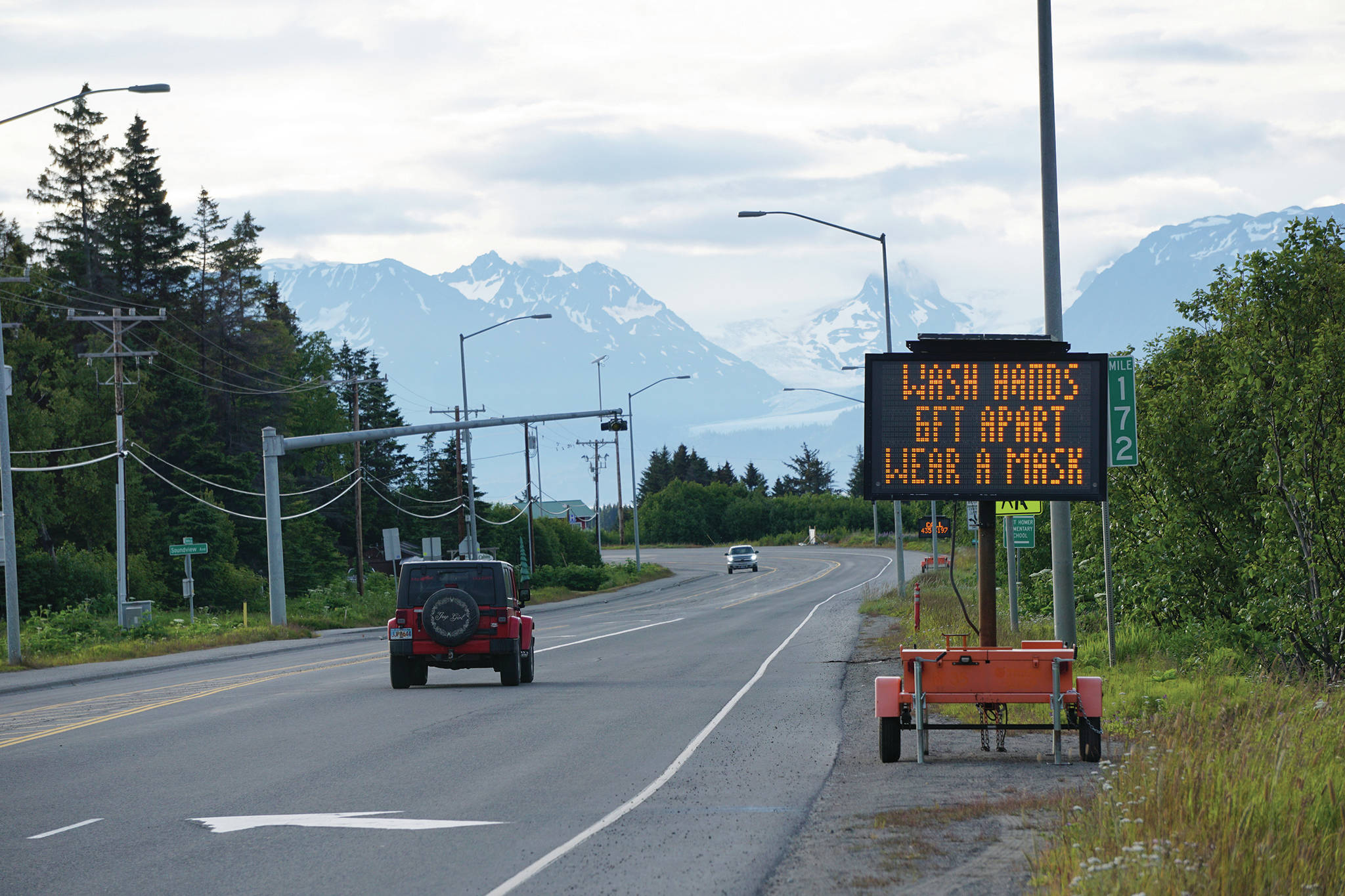As Alaska saw some of its highest daily numbers yet of new positive cases for COVID-19, and as the state heads into the Fourth of July holiday weekend, Gov. Mike Dunleavy urged Alaskans to continue mitigation measures to slow the spread of the novel coronavirus.
That includes wearing face coverings when in confined spaces like grocery stores, practicing social distancing and washing hands frequently, Dunleavy said in a press conference from Anchorage on Tuesday. People also should be mindful of social gatherings.
“Don’t get complacent,” he said. “… Put some distance between you and others. I strongly suggest you do this. … I’m just asking you, especially with this weekend coming, that we show, not just ourselves, but we show this country that Alaskans can think of others.”
For the latest reporting period of midnight to 11:59 p.m. Monday that was announced on Tuesday, Alaska saw 36 new cases of COVID-19 in residents and 12 new nonresident cases, for a resident total of 940, the Alaska Department of Health and Social Services announced in a press release. Resident cases were 21 in Anchorage, five in Fairbanks, four in Seward, two in Palmer, and one each in Eagle River, Juneau, Soldotna and the Valdez-Cordova Census Area. Alaska Chief Medical Officer Dr. Anne Zink said seven recent cases were connected to spread related to contacts in bars.
Twelve new cases were identified, including five in the seafood industry in the combined Bristol Bay and Lake & Peninsula boroughs, two in the tourism industry and one unknown in the Kenai Peninsula Borough, two in the seafood industry in the City and Borough of Sitka, one unknown in Anchorage and one in the seafood industry in Dillingham. That brings that total number of nonresident cases to 195.
Of the 36 Alaska cases, 18 are male and 18 are female. One is under 10; one is aged 10-19; nine are aged 20-29; nine are aged 30-39; seven are aged 40-49; three are aged 50-59; four are aged 60-69 and two are aged 70-79.
Recovered cases now total 526, with one new recovered case recorded yesterday. A total of 112,185 tests have been conducted. The average percentage of daily positive tests for the previous three days is 1.48%.
That positivity rate puts Alaska at the lowest in the nation, with its overall test numbers ranked sixth.
As of June 28 for the 14-day average, the Kenai Peninsula has the highest numbers per 100,000 population, at 3.9, followed by Fairbanks at 3.2 per 100,000 and Anchorage at 2.4 per 100,000. Statewide the average per capita rate of positive cases is 2.4 per 100,000. The Juneau Region has the lowest rate of 1.6 per 100,000.
“Numbers are growing,” Dunleavy said. “… We have more mixing. We have travel. We have folks coming from Outside to work in Alaska. Our positives are going up. We knew that.”
Death rates are still low, with 14 deaths of Alaska residents, with four of them having died in the Lower 48.
Dunleavy said state health care resources remain strong. Of 1,900 beds, 1,000 are occupied. Intensive care unit beds are 198 total, with 91 occupied. The ventilator capacity is 347, with 27 used; only one is for a COVID-19 patient. The hospitalization rate for Alaska COVID-19 patients is 9 per 100,000, compared to the national rate of 98 per 100,000. Anchorage hospitals are running at 80% capacity, Zink said.
“Our equipment and bed capacity is still in pretty good shape,” Dunleavy said.
The spike in cases could raise concerns about plans to reopen schools in the fall, but in response to a question from the Homer News on that point, Dunleavy said it’s too early to predict how schools will reopen.
“This is a once-in-a-lifetime event. It’s a pandemic,” he said. “… A lot of these answers we simply don’t know. … We’re gearing up for a couple of different possibilities. … We’re trying to come up with a number of contingencies.”
With increases of cases at contact points like bars, Dunleavy was asked if we he might dial back some of the health mandates. He said the state was constantly looking at COVID-19 trends and how to respond.
“Everything is on the table to fight a pandemic. There is no doubt about that,” Dunleavy said.
Responding to the pandemic is like squeezing a long balloon, he said.
“You can press on one side (and) it’s manifested somewhere else in the system,” Dunleavy said. “… We’ll take a look at this. We’ll act appropriately on behalf of Alaskans.”
As a mitigation measure, face coverings are sometimes controversial.
“You know, the whole concept of a mask, a face covering, is becoming politicized. It shouldn’t be that,” Dunleavy said.
Evidence shows that people should limit projection like coughing or sneezing to keep the virus from spreading, Dunleavy said. Masks can help do that.
“I think most people would say, if you can limit your projection, your cough, your sneezing, that means you help,” he said.
People should think about why others wear masks, he said. Dunleavy said he wears a mask when he goes into stores or is in confined spaces where it’s hard to maintain social distancing.
“If you can wear a face covering when you go into a grocery store, I want to leave you with a thought,” he said. “Next to you might be an individual who is going home to a child undergoing cancer treatment. Next to you might be a young man going home to his parents … he’s got elderly parents.”
On the lower Kenai Peninsula, South Peninsula Hospital reported Tuesday that it had done 4,216 total tests, with 76 total tests coming back positive, 4,040 negative test and 100 pending tests. At the SVT Health & Wellness Clinic, 511 tests have been done, with 11 total positive cases, 499 negative tests and one test pending.
Reach Michael Armstrong at marmstrong@homernews.com.

